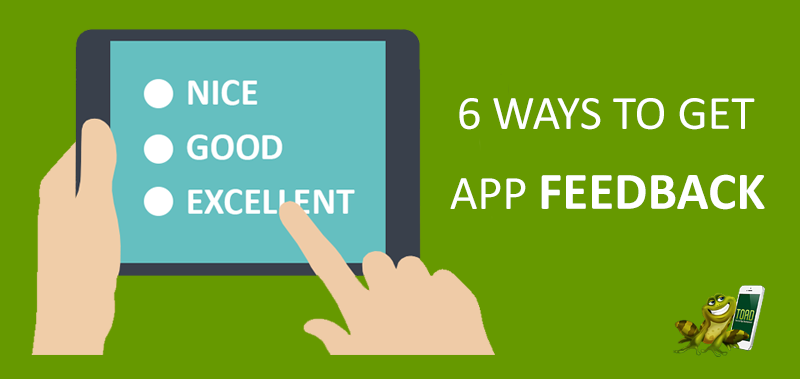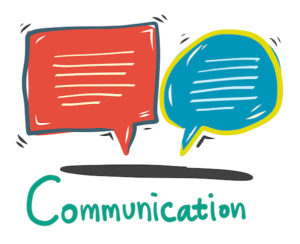27 Jul 6 Ways to Gather App Feedback Effectively
Creating a successful mobile app is not something you build out of the box. You can’t make an app, release it and then instantly it becomes an overnight sensation. In its entirety, the success of an app is the result of hard work and a ton of dedication. But despite all that, success can still be out of reach without the real participation of your users.
Collecting feedback is an indispensable part of an app’s success. You can do extensive research to build the pieces of your app, but still, you can not fully understand what your potential users really want. This is when feedback becomes a force to reckon with that bridges the gap between your own creative imagination and the critical need for your users. The key is to make your design open to improvements and modifications in order to model your app to your user specifications.

Feedback can give developers meaningful and actionable insights on how customers truly want to use it. It is an integral part of app marketing that developers should take into careful consideration. And, with a well thought-out feedback strategy, obtaining this information should be a bit easier. For instance, you can get information as to why some users stopped using your app at a certain point or what pushes them to uninstall your app. Feedback from users validates your app analytics data and make them more relevant in helping you create better decisions.
Every feedback is critical to your app growth so we have put together a list of how to gather feedback that could power your next plan of action.
6 Effective Ways To Collect App Feedback
Various methods and strategies are available to developers who want to harness the power of open communication and feedback. Whether it is a good or a bad feedback, anything that comes from the users concerning your app are valuable pieces of information that will ensure your long term success.
1. Ask for Reviews
The most basic way to get your customers to talk is by asking them for reviews. Sometimes, developers tend to blot this out from their marketing strategy because this does not seem to work at first. But with careful planning, this has actually been proven to be an effective way of collecting user feedback.
Android and iOS platforms have made it easy for developers to integrate ratings and review requests from within the apps. However, perfect timing is critical to get the most out of this strategy. The failure of most developers comes from asking for reviews and ratings just when the user has installed the app. This can be very annoying to the new customers and certainly, it does not give a very good impression. These new users are not even familiar with your app yet they are being asked to give it a rating. Wait until after a few sessions before firing up a review request. This is just to make sure that they might now have something to say about your app. (Recommended reading: 5 Ways Game Developers Benefit from Bad Reviews)
Once you see the reviews coming in, make sure to find time to read through them and respond if necessary to reassure your users that you do listen to their comments. And in most cases, because your users’ expect it – do your best to address the issues.
In the end, app store reviews are not only beneficial to potential users but they can also influence the overall discoverability of your app.
2. Set up your own in-app feedback system

You can level up your feedback system by establishing two-way communication right within your app. When users try to communicate with you, don’t make them leave the app, let them contact you right there and then. It is a great way to gather feedback while building a strong user relationship.
By having this feedback gathering system in place, you will always be listening to your customers. It will ensure that you are getting their feedback and getting the issues they are facing resolved.
A lot of tools are available for developers to use to integrate this module into an app seamlessly. These tools will allow users to capture bugs as they encounter them. Most in-app feedback system modules also allow rich-content feedback which will make the process even easier for the users.
3. Use In-App Net Promoter Score (NPS) Surveys
 NPS is a reliable and extremely simple surveying technique that allows you to measure general user sentiment. Basically, you only need to ask one question in order to get the data needed. The question could go something like: “How likely are you to recommend my app name to a friend or colleague?”. Answers are based on a 0-10 scale.
NPS is a reliable and extremely simple surveying technique that allows you to measure general user sentiment. Basically, you only need to ask one question in order to get the data needed. The question could go something like: “How likely are you to recommend my app name to a friend or colleague?”. Answers are based on a 0-10 scale.
Developers can easily integrate Net Promoter Score into an app. Various tools are available to do the work seamlessly and effectively. With NPS in place, personalized feedback from your users is within your reach.
 Image by agentflare.com
Image by agentflare.com
Based on their answers, the respondents can be classified into 3 categories: Promoters, Passives, and Detractors. Once you have determined which group a user belongs, you can then take specific actions. For instance, you can target those who are promoters and ask them to leave a review on the app store. Once you make this work, a positive review is a guaranteed and can surely make an impact on your overall ratings.
Part of the NPS strategy is a follow-on question, which will ask users to give a quick explanation for their answers. Having this information allows you to execute a personalized and solid action plan.
4. Don’t forget about E-mail
Emails can still play a big role in the modern age of apps. Creating a solid email feedback system will allow you to gather data that you won’t get using any other medium. Some users still prefer to use email as a proper way of communicating especially if the concern matters to them. Email is personal. It gives users the assurance that their feedback will be heard and subsequently will get resolved.
Plan a simple but efficient email system that will ensure that every email that comes concerning your app gets a proper attention. Just like the other ways of getting feedback we’ve mentioned, always reassure your users that you heard them by giving them a speedy response. You must also let them know that you are doing something about the issues that they are facing while using your app.
Every now and then, it is also a good idea to send an email directly to your users asking them about their experience with your app and letting them know that you are willing to listen to their concerns. So, you might want to start collecting user email addresses. You must do it in a fashionable way though lest you annoy them. Give them enough reason to give out their email to you. You can offer discounts or freebies in exchange for their emails and make sure that you only communicate with them if you really have to. For simple updates, you can always use social media to do it.
Another thing about email is that it is easier to organize. Users will find it straightforward to follow the conversation and refer to it later if need be. Also, most users who prefer to send feedback using email are the ones who are loyal and they tend to provide valuable information and even unique ideas for the app. On top of that, email allows rich-content feedback and can accept various files as an attachment including the different type of images. This is helpful at certain times when users find it inconvenient to describe complex scenarios. They can just annotate a screenshot and attach it to their message.
5. Use Questionnaire
At some point, it is also ideal to just run a questionnaire campaign as compared to asking for real reviews. Some users do not know exactly what they like or not like about your app, so they wouldn’t know what to put in those text boxes or emails. Whereas, when you present them with a set of targeted questions answerable by yes or no or some multiple-choice answers, it would be easier to collect their feedback. It would also be a convenient way of giving feedback when using a mobile phone. The process is simple and users are most likely willing to answer a questionnaire.
However, advance planning is required to use this approach. You need to determine which feedback points in your app you want to gather at that moment. You will build up your questions around them and make sure that the questions are not too long. The key is to get the most amount of information from the least amount of questions.
6. Create savvy support communities
The world outside mobile still matters to your app. Remember that your users live on every corner of the internet. You can find them in social media, blogs, and forums. So, it is to your advantage if you set up support communities in these areas. It will help you gather feedback easily. You can create a blog for your app where users can read recent releases and updates. Make sure that the comments section is open so that your users can voice out their opinions about a certain topic.
 Image by Freepik
Image by Freepik
You can offer Twitter support for those who are frequent tweeters. They can simply send a tweet or a private message to you to give their feedback or ask a question. For people who use Facebook a lot, you can create a page for your app or even a Facebook Group dedicated to the users of your app.Your users will be thrilled if they can interact with you on these platforms. Feedback will certainly come easily once they get acquainted with you.
Aside from building social media communities, social listening is also an important way to gather feedback. Monitor hashtags and mentions in status updates and comments that might be related to your app. Social media is a place where people voice out their opinions for just about anything. And, this happens when they are both happy and disgusted about a product or service. Be on the look out and always be ready to interact if you deem necessary.
Another way of creating an off-app community is to participate in forums related to your app. Create a subforum and start building a following. Additionally, making your presence felt in discussion websites such as Reddit is hard to miss. Engage with your users and let them know that you are interested in sustaining a long term relationship.
Lastly, listing your app in feedback websites will enable you to get feedback in a whole different way. Websites like Get Satisfaction, Kampyle, UserVoice and Feedbackify offer a streamlined service mainly designed to manage customer engagement and get actionable feedback. Though these services come at a cost, it is something you might want to consider especially if your user base is becoming larger.
CONCLUSION
Collecting feedback for your app is easy and convenient with the tools and ways we mentioned above. It should not cost you a lot if you know how to value your user’s voices and learn how to communicate well.
We can’t emphasize it more, developers should put this on their priority list. Gathering feedback and making necessary actions is undeniably one of the key components to an app’s success.
Be creative and innovative in collecting feedback. You want to make sure that you plan ahead and have clear objectives in doing so. Gathering feedback does not only let you position your app to meet the actual requirements of your target users but it also allows you to build a long-lasting relationship with them. And, certainly, that matters to your app’s success.
If you enjoyed this article, sign up for our list to get the latest updates on app marketing and app store optimization best practices. Subscribe now!



